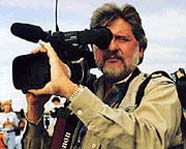|
|
Letter
from |
Welcome to the August
2003 issue of The Digital Journalist, the monthly online magazine for
visual journalism.
While American troops and Arab civilians continue to die in the streets
of Iraq, another bloody conflict has been dominating the front pages.
The war between the government of President Charles Taylor and Liberian
rebels, which has been going on for the past five years, rages on, and
recently it has become even more horrific as it spills into the capital
of Liberia. Photographer Chris Hondros has been on the bloody streets
for the past month, and he reports with a gallery and a heart-rending
dispatch from Monrovia.
Three years ago, we reported on how a big city newspaper, The Newark Star-Ledger, had reinvented itself to win a Pulitzer Prize in photography. This month, we visit a small paper in the heartland, The Lawrence Journal-World. We were curious about this 20,000-circulation daily which was regularly winning awards for its Web site. What we found was that not only does the newspaper have the online area right, but it is indeed a model for how a newspaper can spread its brand in print, on television, and on the World Wide Web. We feature a gallery by the Journal-World staff photographers and streaming video interviews with the editors, publisher, and Web master in our feature Driving with Your Brights.
We have just concluded our ninth Platypus workshop at the Brooks Institute in Ventura, California. This year we also added the first Advanced Platypus Workshop, which considers how the emergence of new technology is paving the way to allowing digital video producers to enter the big-time world of filmmaking. We want to thank Canon for supporting these workshops. Contributing Editor Pat Sloyan writes about what it was like for a writer to find himself with a classroom full of still photojournalists and face the terror of having to learn a whole new craft. Amy Bowers reports on the Advanced Workshop.
Young photojournalist Ricky Flores reports on a week that changed his life, as he attended a workshop sponsored by the National Hispanic Journalists Association in New York. New York Times publisher Arthur Sulzberger addressed the workshop during the storm over the Jason Blair scandal. Ricky comments on how that issue has affected his life as a minority journalist.
In our columns, Jim Colburn is back from vacation, and
writes about how the new FAA regulations make cameras a target for security
people in airports as they look for terrorist weapons. Jim Parisi recounts
his delight from a few weeks ago when he rediscovered "how cool it
is to be a photographer." Bill Pierce muses on how the White House
sometimes makes a photographer's job harder, and what that can do to history.
Amy Bowers celebrates the return of her Betacam seven years and eight
months after it was taken from her by the Montana Militiamen, and Ron
Steinman looks back at a rough assignment in Brazil for NBC.
We hope you enjoy this issue.
A SPECIAL NOTE ON SPAM AND OUR MAIL LIST
Every month we put out our newsletter to readers of The Digital Journalist. Most of you have joined our mailing list, which is accessible on our Contents page. Others have been added from my personal address list. In recent months, we have noticed a major increase in returned emails. We suspect a lot of these are due to readers installing anti-spam software on their computers or on their networks. If you want to continue to receive these newsletters, it is important that you authorize your filter to let us through.
We will never pass on any email addresses to third parties.
Dirck Halstead
ASSIGNMENT SHEET
Mark Neuling, a videographer for Tech TV, has been a valued asset to Assignment Sheet. His monthly journals describe the workings of any one of us who are photojournalists for still or tv. Fighting deadlines, traffic, recalcitrant reporters and editors, equipment problems; the gamut that all of us deal with on a daily basis. And this month's journal, "I READ THE NEWS TODAY" is no exception. Enjoy it. I did.
There have been a lot of recent messages being posted on the NPPA-L in regard to Cameras in the Court. There have been advocates postulating that Cameras in the Court is a right. Others hold that it is a privilege. A number of years ago, New York State conducted an experiment allowing Cameras in the Court. It lasted for several years but it was allowed to die before legislation making it law was ever enacted. I was involved in that experiment and wrote several Through a Lens Dimly articles about my experiences at the time. I am posting them once more, on Assignment Sheet for this month. I hope that you will read "THROUGH A LENS DIMLY_CAMERAS IN THE COURT #1, #2, #3 and #4, by Dick Kraus. Even though New York State no longer allows trials to be photographed, there may be some useful information for those of you who work in more enlightened states.
Dick Kraus
Editor of Assignment Sheet
